
I love wrist watches. My grandfather was a clockmaker, so it’s probably a genetic thing. The family story is that he narrowly avoided execution during WW2 by offering to mend the officers’ watches. (I had assumed this was at the hands of the Germans, but it may well have been the communists).
The following are my favourite six watches in my collection. I wear all of these fairly often. They cover some of the main watch styles, so are a good representation. I mostly like simple stainless steel designs with black faces. As with my previous ‘collection’ series of articles, I will focus on aesthetics more than technical matters, but will highlight distinguishing technical features on each watch. Apart from the final watch, these are 100% mechanical watches – which means they are manual wind, or also have a weighted rotor which self-winds the watch from normal wear (an automatic).
A note on size – Although photos don’t convey it well, I think one of the most important aspects of a watch is its size – measured in mm across the face. Most of my watches are on the smaller size. Watch diameters have increased dramatically over the years, and I find this trend unattractive in general. Whilst a large diving watch with a bezel makes sense functionally, the size change in all watches has been driven by fashion and the desire for bling. In the last few years, however, the oversized trend seems to be reversing with leading brands re-producing some of their smaller classics.
Longines Legend Diver (44mm)
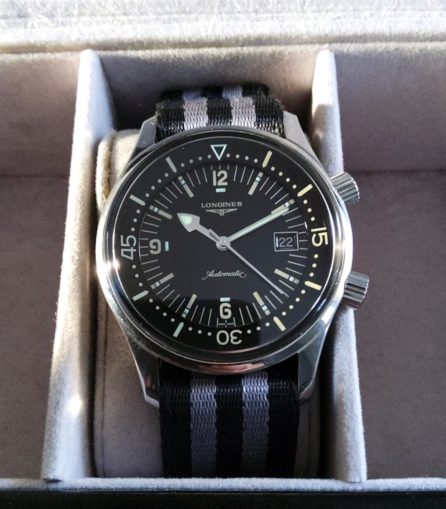
Longines is the oldest trademarked watch brand and has done a superb job in reissuing some of its classic designs from previous years. This Legend Diver is an almost exact copy of one of its 1960’s diving watches. This version has the added date, which I like to have in a daily wearer. (They also produced a now discontinued no-date version that is much more valuable as watch enthusiasts value authenticity above practicality.)
The unique feature on this watch is the internal rotating bezel which sits fully underneath the domed sapphire crystal. The bezel can be used to time scuba dives using the top crown to rotate it. Diving watches with their outer bezel were originally all used by scuba divers, but now mostly adorn the wrists of city traders. I have actually used my watch to go diving once whilst on holiday in Egypt, but mainly use it to time cooking! The original strap has worn out, so I’m wearing it on a very secure nato strap. For me, this design is just so perfect with all those long minute markers. It has a wonderful 60s feel and the watch just grabs the eye but in a subtle way. I love the Longines brand and it offers good value for money if you want a premium watch without paying Rolex level prices.
An aside on movements… An important feature of mechanical watches is the quality of the movement mechanism. Companies such as ETA make standardised movements, whilst more expensive watches like Rolex or Omega develop ‘in-house’ movements. My Legend Diver uses the ETA 2824-2 movement upon which Longines has made some improvements. I’ve got quite a few watches which use this movement and it is a dependable workhorse. I’ve not had my Longines serviced yet, despite it being 10+ years old, and it’s still accurate to +/- a couple of seconds per day, which is very good.
Rolex Explorer 14270 (36mm)
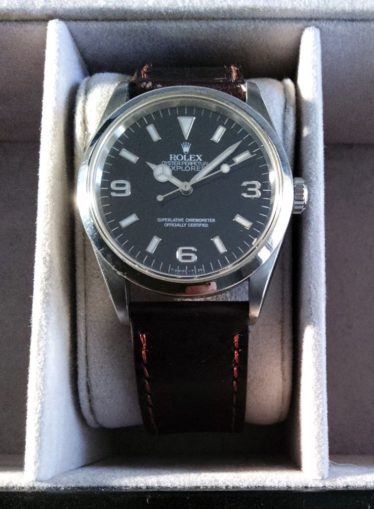
The Rolex Explorer 14270 is the crown jewel of my collection. My favourite watch of all time is the previous reference in the Explorer range – the Rolex 1016. The 1016 was produced from 1963 to 1989 and is the watch Ian Fleming wore and gave to James Bond. The 14270 was the next in the series introduced in 1989, and added a bit more Rolex bling to the numerals. Unfortunately, 1016s are now incredibly sought after and cost way too much for me to justify. I managed to pick this 14270 up about 5 years ago. Just as 1016 prices have gone crazy, my 14270 has more than doubled in value since I bought it. There is even a rumour that someone has bought up all of the 14270/114270s in the UK and is drip feeding them back onto the market. One thing that will strike you about these 36mm Rolexes is just how small they look compared to the equivalent 39mm models. Many watch wearers struggle with this issue, and especially if they have larger wrists they are drawn to bigger watches. I’m a purist and think the original sized dials are aesthetically superior. WW2 was fought by tough, broad-wristed men, all wearing 34mm watches max. It seems Rolex has finally realised smaller is in many respects better as they have recently re-issued the 36mm Explorer. Good luck finding one though.
The Rolex Explorer is technically a sports watch, although I tend to reserve mine for special occasions rather than mountain climbing. Many claim it is the perfect ‘one watch’ because of its versatility. My version is one of the earlier models and has a tritium dial for ‘night glow’. Tritium was banned and replaced by non-radioactive LumiNova in the late 1990s. Due to the half-life of tritium being 12 years, my watch has very little ‘glow’ left in it. However, the benefit of tritium is that over time the markers turn that yellow colour you see in vintage watches. Mine is beginning to get this patina, so I think this will only add to its collectibility. You’ll see I’ve swapped out the famous oyster bracelet for a shell cordovan leather strap.
Although I love my 14270, the simpler dial of its predecessor the 1016 continues to call to me. Which brings us to the next watch in my collection, which reproduces the 1016 classic.
Smiths Everest PRS-25 (36mm)
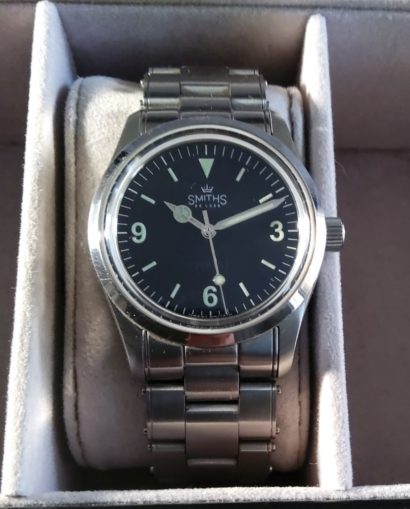
Although the Rolex Explorer is associated with the first summit of Mount Everest, Edmund Hillary actually wore a British Smiths watch to the summit. In more recent years, the Smiths brand name was bought by a small online watch outfit – timefactors.com. The owner of Timefactors now creates watch designs, usually based on classic designs, and then has the watches made in limited batches. You don’t get a ‘swiss made’ watch but I can attest to the superb quality of the timefactors watches and their remarkable prices. Timefactors has a very obsessive following from watch enthusiasts who appreciate being able to buy classic design features without all of the marketing costs of the big brands.
My Smiths Everest is therefore a very faithful reproduction of the Rolex 1016 at a fraction of the cost. (Note, this is not considered a fake or replica watch as it is not copying the branding). This watch gets a lot of wrist time as a result, without me having to worry so much about damaging it.
Smiths PRS-29a (36mm)
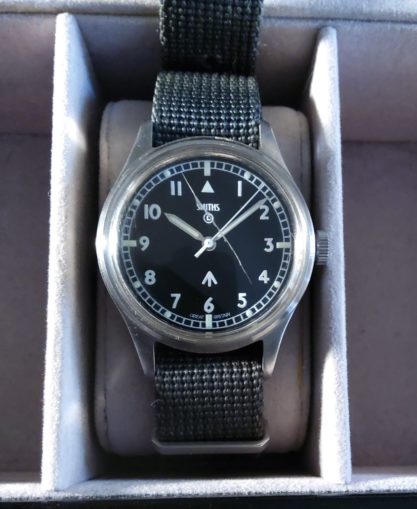
I also have the Smiths PRS 29a, which reproduces the Smiths W10 that the original Smiths company made for the British military between 1967 and 1970. (If you’ve got an original one at the back of a drawer, please sell it to me!) Military style ‘field’ watches have specific design features which prioritise legibility and durability. This watch is manual wind and also has an anti-magnetic shield and fixed lugs for nato straps. My version has an acrylic crystal – this is faithful to the original design and is also safer from a shatterproof perspective. Acrylic makes the watch dial pop out more and gives that vintage look. The downside is that acrylic scratches easily and my watch has a very deep gouge which can’t be polished out. (I have bought a replacement crystal but I’m reluctant to pay the cost of a watchmaker to fit it.) The latest PRS 29a from Timefactors now has a sapphire crystal, which on balance I think is a better option. For me, the Smiths is the quintessential military field watch. It’s great to know that a British company perfected the mechanical field watch design just before digital watches took over.
Nomos Ludwig Datum (37.5mm)

So far we’ve had a diving watch, a sports watch and a field watch. Next up is an elegant and thin ‘dress watch’ designed to slip under the cuff of a shirt. The Germans have a tradition of very high quality watch making in the town of Glashütte in Saxony. Nomos is a newer brand from that town which continues this tradition. It has gained popularity in recent years with its Bauhaus style designs. The USP of Nomos is that you are getting an extremely well made watch from master watchmakers whilst not paying through the tooth for a more flashy brand.
I went for the handwinding version to maximise thinness, and opted for a date option, and roman numerals – just because I like them. (You may have noticed that the roman numeral ‘4’ on watches and clocks is not usually ‘IV’ but ‘IIII’ instead, which looks more balanced.) My Nomos has a glass back which allows you to see the beautiful in-house movement in action. It also has ‘blued’ hands which change colour between black and a metallic blue depending on the light. Since I bought my Nomos 7 years ago the brand has really taken off with lots of new models. I really respect a watchmaker coming up with new and unique designs whilst not compromising on the tradition of engineering excellence.
Casio GW-B5600-2ER
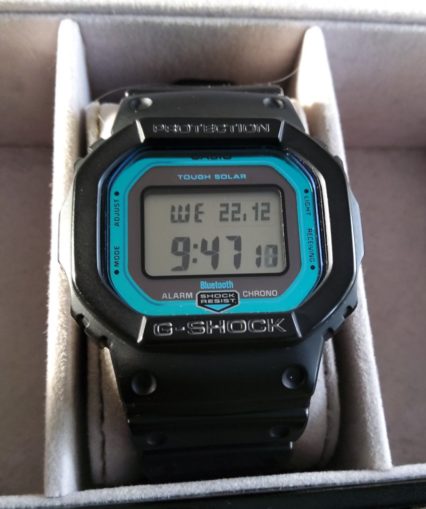
Finally, to show that watch collecting is not all about expensive mechanical watches, we come to the watch I wear the most. The famous Casio ‘Square’ G-Shock. The G (gravitation) -Shock was invented in 1981 and has a unique shock absorption system to enable the watch to take a battering. The watch was made famous by Keanu Reeves in the 1994 film Speed and the discontinued DW-5600C-1V model he wore is now highly collectible. The digital modules in G-Shocks have changed remarkably little in 40 years and will be familiar to anyone who has worn a Casio digital watch. The main changes since the 1980s have been incorporating solar charging and automatic time updates to newer versions. For many years G-Shock Square obsessives lamented that there wasn’t a single version of the watch that had all of the best features. For example, the solar version annoyingly didn’t show you the time when in the stopwatch mode (watch enthusiasts really do obsess about such things). Then, a couple of years ago, Casio released my current new bluetooth version of the Square. This version fixed all of the complaints about the previous modules. The only problem left was that the nice blue version of the watch came with a ‘negative display’, which is much harder to read in sunlight. I fixed this by removing the polarising film on the display and cutting a new piece, rotating it 45 degrees and sticking it in. Hey presto, a negative display modded into a positive one. I’ve just seen that Casio released a new positive display version of this G-Shock in a nice colour – the GW-B5600MG-1. I would go as far to say that this is now the best wrist watch ever produced.
What’s next for my collection?
I have (pretty much) decided not to buy any more watches. There are a few reasons for this. Cost is obviously one. I was fortunate enough to buy some of these watches when I had a bit more disposable income. Interest free monthly payments over 5 years also make watch purchases hardly noticeable. There is also the cost of servicing mechanical watches to consider. Services need to be done every few years to keep the watch ticking away. A watchmaker will completely disassemble, clean, and reassemble all of the parts. This takes time and is highly skilled – hence expensive. But the main reason to not increase the collection is that I’m really happy with the watches I own and want to be able to spend enough time with each of them. However…, I would quite like to own a vintage Omega Seamaster 600.
© text & images JimmySP 2022



